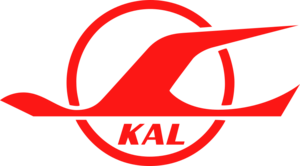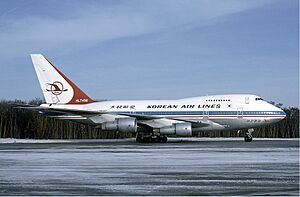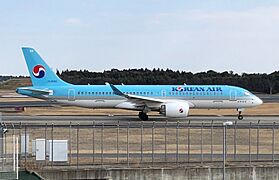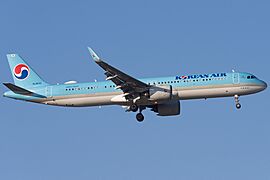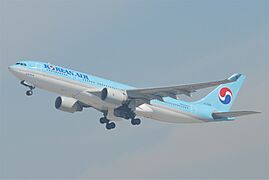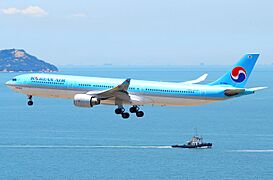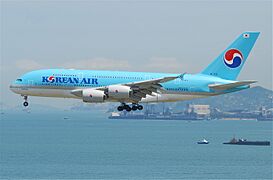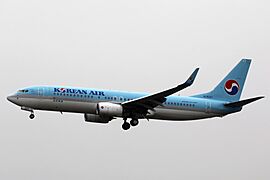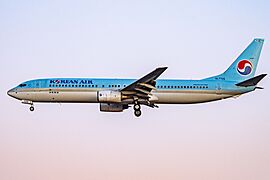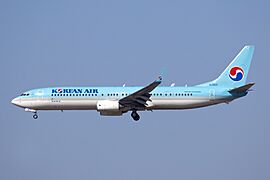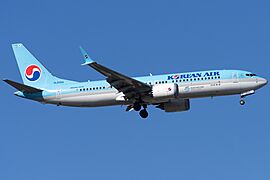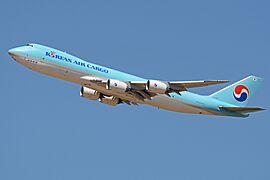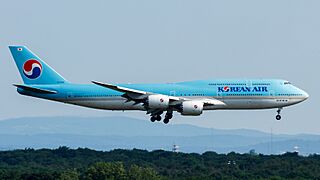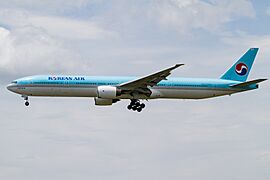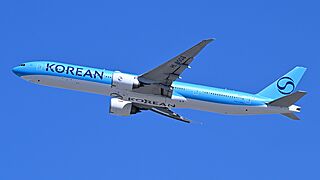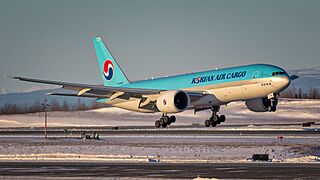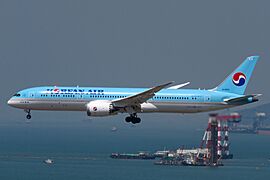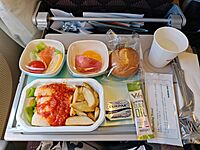Korean Air facts for kids
Korean Air Boeing 777-300ER
|
|
| Founded | June 1962 |
|---|---|
| Commenced operations | 1 March 1969 |
| Hubs |
|
| Focus cities |
|
| Frequent-flyer program | SKYPASS |
| Alliance | |
| Subsidiaries |
|
| Fleet size | 167 |
| Destinations | 108 |
| Parent company | Hanjin Group |
| Headquarters | 260 Haneul-gil, Gangseo District, Seoul, South Korea |
| Key people | Walter Cho (Chairman & CEO) Woo Kee-Hong (Vice Chairman) Yoo Jong-Seok (COO & Chief Safety Officer) |
| Revenue | |
| Operating income | |
| Net income | |
| Total assets | |
| Employees | 20,000 |
| Korean name | |
| Hangul |
대한항공
|
|---|---|
| Hanja |
大韓航空
|
| RR | Daehan hanggong |
| MR | Taehan hanggong |
Korean Air (also known as KAL) is the main airline of South Korea. It is the largest airline in the country. It has the most planes, flies to the most international places, and has the most international flights. The airline is part of the Hanjin Group.
Korean Air started on March 1, 1969. This was when the Hanjin Group bought the government-owned airline called Korean Air Lines. That airline had been flying since June 1962. Korean Air is a founding member of the SkyTeam alliance and SkyTeam Cargo.
As of 2024, Korean Air is one of the top 10 airlines with a "5-star" rating from Skytrax. It is also among the top 20 airlines in the world for the number of passengers it carries. It is also a top international cargo airline.
Korean Air's passenger and cargo flights serve 126 cities in 44 countries. Its flights within South Korea go to 13 different places. The airline's main office is in Seoul, South Korea.
In November 2020, Korean Air announced it would merge with another airline, Asiana Airlines. The plan changed to Korean Air buying a large part of Asiana Airlines. This happened after the first merger plan was stopped by the United States. The purchase was completed on December 12, 2024.
Contents
History of Korean Air
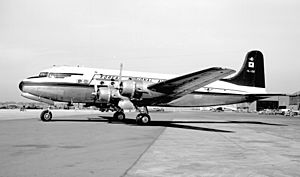
How the Airline Started
In 1962, the South Korean government bought Korean National Airlines. This airline was founded in 1946. The government changed its name to Korean Air Lines.
On March 1, 1969, the Hanjin Group bought this state-owned airline. This was the true beginning of the Korean Air we know today. Long-distance cargo flights across the Pacific Ocean started on April 26, 1971. Passenger flights to Los Angeles International Airport began on April 19, 1972.
Growing the Airline

Korean Air flew international flights to places like Hong Kong, Japan, and Taiwan. It also flew to Los Angeles using Boeing 707 planes. In 1973, the airline started using Boeing 747s for its flights across the Pacific. It also began flights to Paris, France, first with the 707 and then with the McDonnell Douglas DC-10.
In 1975, Korean Air was one of the first Asian airlines to use Airbus planes. It bought three Airbus A300s, which quickly started flying on Asian routes. In 1981, Korean Air opened a cargo terminal at Los Angeles International Airport.
Changing to 'Korean Air'
On March 1, 1984, the airline changed its name to Korean Air from Korean Air Lines. It also introduced a new look for its planes. This new design had a blue top, silver bottom, and a new "Korean Air" logo. The logo featured a special Taegeuk design. This new look was first seen on its MD-80s and Boeing 747-300s.
In the 1990s, Korean Air was the first airline to use the new McDonnell Douglas MD-11. These planes were meant to fly alongside its new Boeing 747-400 aircraft. However, the MD-11s did not perform as well as the airline needed. They were later changed into cargo planes. Some older 747 planes were also changed to carry cargo.
Improving Safety
Korean Air has worked hard to improve its safety record. In the past, the airline had a number of serious incidents. However, it has made big changes to become much safer.
Between 1970 and 1999, 16 Korean Air planes were lost due to serious incidents. More than 700 lives were lost during this time. For example, in the case of Korean Air Flight 801, investigators found that pilot training issues played a part in the accident.
In 1999, Delta Air Lines stopped its partnership with Korean Air. They said it was because of safety concerns after a cargo plane crash. Other partners like Air Canada and Air France also followed.
In 2001, the Federal Aviation Administration (FAA) lowered South Korea's aviation safety rating. This meant South Korean airlines could not expand their flights to the United States. This happened because the country and its airlines had not improved enough after a warning.
Since then, Korean Air has spent a lot of money to make flying safer. They upgraded their planes, added new technology, and changed their company culture. They even hired experts from Boeing and Delta Air Lines to help. By 2002, the New York Times reported that Korean Air was no longer on many "avoid" lists. The FAA has since restored South Korea's safety rating.
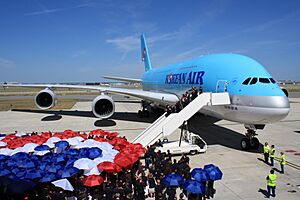
Early 2000s
On June 23, 2000, Korean Air helped create a major airline alliance called SkyTeam. Other airlines like Aeroméxico, Air France, and Delta Air Lines were also part of this. SkyTeam Cargo was also founded on September 28, 2000.
On June 5, 2007, Korean Air announced it would start a new low-cost airline in Korea called Jin Air. This was to compete with Korea's fast train system, KTX, which offered cheaper travel. Jin Air began flying passengers on July 17, 2008. Korean Air gave some of its 737s and A300s to Jin Air.
In 2013, Korean Air bought a 44% share in Czech Airlines. They sold this share in October 2017. On May 1, 2018, Korean Air started a partnership with Delta Air Lines.
In 2019, Korean Air began showing a safety video featuring the K-pop group SuperM. The airline also put the group's image on a Boeing 777-300ER plane.
In 2023, Skytrax gave Korean Air a 5-star Airline certification. In 2025, Korean Air bought a 10% share in the Canadian airline WestJet.
The "Nut Rage" Incident
In late 2014, a high-ranking executive at Korean Air, who was the daughter of the chairman, resigned from some of her duties. This happened after she ordered a plane to return to the gate. She wanted a flight attendant removed from the aircraft because of how nuts were served. She was later arrested by Korean authorities for breaking aviation safety rules.
Merger with Asiana Airlines
In November 2020, the South Korean Government announced that Korean Air would buy Asiana Airlines. The plan was to combine their low-cost airlines, Air Busan, Air Seoul, and Jin Air, into one new airline. This new airline would focus on smaller airports in Korea.
The merger with Asiana Airlines was completed on December 12, 2024. Korean Air bought 63.88% of Asiana Airlines. This deal made Korean Air the 12th largest airline in the world based on international flight capacity.
New Look for the Airline
On March 11, 2025, Korean Air showed off its first major new look since 1984. This was part of its merger with Asiana Airlines. The old "Taegeuk" symbol, which was blue and red, changed to a dark blue outline of the same symbol. The words "KOREAN AIR" also changed from an older style to a new, simpler font. This new look helps the symbol stand out more. New uniforms for Korean Air and Asiana employees will be introduced in 2027, showing the unified "Korean Air" brand.
How Korean Air Works
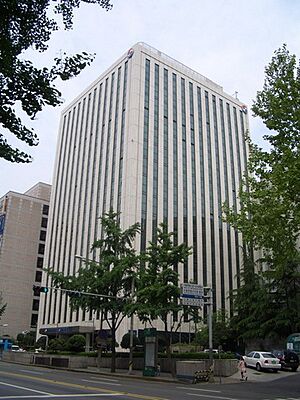
Who Owns Korean Air
Korean Air is owned by the Hanjin Group. Most of it is controlled by Hanjin KAL Corporation. Walter Cho, the current chairman and CEO, is the third person from the family that controls Hanjin KAL to lead the airline. Delta Air Lines is the largest shareholder of Hanjin KAL, owning 14.90%. As of June 5, 2020, Hanjin KAL owns 29.27% of Korean Air shares.
Main Airports and Offices
Incheon International Airport Terminal 2 is Korean Air's main international airport hub.
Korean Air's main office building is located near Gimpo International Airport in Seoul. The company also has another main office campus in Incheon.
Other important airports for Korean Air are Jeju International Airport in Jeju and Gimhae International Airport in Busan. The places where planes are fixed and maintained are at Gimhae International Airport. Most of Korean Air's pilots, ground staff, and flight attendants work from Seoul and Busan.
Hotel Ownership
Korean Air owns four hotels. Two of these are KAL hotels on Jeju Island. One is the Hyatt in Incheon. The fourth is a hotel and office building called the Wilshire Grand Tower in Los Angeles. This building in downtown Los Angeles has the largest InterContinental Hotel in the Americas. It is also the tallest building in Los Angeles.
Korean Air Aerospace Division
Korean Air also has a part of its company that works on aerospace. This division is called the Korean Air Aerospace Division (KAL-ASD). It has made licensed versions of helicopters like the MD Helicopters MD 500 and Sikorsky UH-60 Black Hawk. It also made parts for fighter jets like the Northrop F-5E/F Tiger II and the KF-16.
KAL-ASD also makes parts for many commercial planes. These include parts for the Boeing 737, 747, 777, and 787 Dreamliner. They also make parts for the Airbus A330 and A380. In 1991, this division designed and flew its own light aircraft called the Korean Air Chang-Gong 91. KAL-ASD also helps maintain aircraft for the United States Department of Defense in Asia. It has a research team that studies things like rockets, satellites, and military aircraft.
Where Korean Air Flies
Partner Airlines
Korean Air works with other airlines through "codeshare agreements." This means they can sell tickets on each other's flights. Here are some of the airlines Korean Air partners with:
- Aerolíneas Argentinas
- Aeroméxico
- Air Europa
- Air France
- Air Tahiti Nui
- Air New Zealand
- Alaska Airlines
- Aurora
- China Airlines
- China Eastern Airlines
- China Southern Airlines
- Delta Air Lines (Joint Venture Partners)
- Emirates
- Etihad Airways
- Garuda Indonesia
- Gol Linhas Aéreas Inteligentes
- Hainan Airlines
- Hawaiian Airlines
- ITA Airways
- Japan Airlines
- Jin Air (Subsidiary)
- Kenya Airways
- KLM
- LATAM Brasil
- LATAM Chile
- LATAM Perú
- Malaysia Airlines
- MIAT Mongolian Airlines
- Myanmar Airways International
- Rossiya Airlines
- Royal Brunei Airlines
- Saudia
- Scandinavian Airlines
- Shanghai Airlines
- SriLankan Airlines
- TAROM
- Uzbekistan Airways
- Vietnam Airlines
- Virgin Atlantic
- WestJet
- XiamenAir
Korean Air also has "interline agreements" with these airlines:
- Air Premia
- JetBlue
Korean Air is also a partner with Skywards, which is the frequent-flyer program for Emirates. Members of Skywards can earn and use miles when flying with Korean Air.
Korean Air Fleet
Current Aircraft
As of June 2025, Korean Air uses these aircraft:
| Aircraft | In service | Orders | Passengers | Notes | |||
|---|---|---|---|---|---|---|---|
| F | J | Y | Total | ||||
| Airbus A220-300 | 10 | — | — | — | 140 | 140 | Order with 10 options and 10 purchase rights. |
| Airbus A321neo | 16 | 40 | — | 8 | 174 | 182 | Order with 20 options. |
| Airbus A330-300 | 18 | — | — | 24 | 248 | 272 | |
| 24 | 252 | 276 | |||||
| 260 | 284 | ||||||
| Airbus A350-900 | 2 | 4 | — | 28 | 283 | 311 | Deliveries started in January 2025. |
| Airbus A350-1000 | — | 27 | TBA | ||||
| Airbus A380-800 | 6 | — | 12 | 94 | 301 | 407 | Originally planned to be retired in 2026. Currently postponed. |
| Boeing 737-800 | 2 | — | — | 12 | 126 | 138 | |
| Boeing 737-900 | 9 | — | — | 8 | 180 | 188 | |
| Boeing 737-900ER | 6 | — | — | 8 | 165 | 173 | |
| Boeing 737 MAX 8 | 5 | 24 | — | 8 | 138 | 146 | Order with 20 options. |
| 150 | 158 | ||||||
| 1 | VIP | Leased to Republic of Korea Air Force for VIP transport. | |||||
| Boeing 747-8I | 5 | — | 6 | 48 | 314 | 368 | Includes HL7644, the last passenger 747 ever built. |
| 1 | VIP | Leased to Republic of Korea Air Force for VIP transport. | |||||
| Boeing 777-300 | 4 | — | — | 41 | 297 | 338 | |
| Boeing 777-300ER | 25 | — | 8 | 42 | 227 | 277 | All to be retrofitted with new Prestige Suites 2.0 and have Kosmo Suites removed. |
| 8 | 56 | 291 | |||||
| Boeing 777-9 | — | 20 | TBA | Deliveries from 2028. | |||
| Boeing 787-9 | 14 | 6 | — | 24 | 245 | 269 | Order with 10 options. Order was converted from Boeing 787-8. |
| 254 | 278 | ||||||
| Boeing 787-10 | 10 | 30 | — | 36 | 289 | 325 | Order with 10 options. |
| Korean Air Cargo fleet | |||||||
| Boeing 747-400ERF | 4 | — | Cargo | ||||
| Boeing 747-8F | 7 | — | Cargo | ||||
| Boeing 777F | 12 | — | Cargo | ||||
| Korean Air Business Jet fleet | |||||||
| AgustaWestland AW139 | 4 | — | 8–14 | ||||
| Airbus Helicopters H160-B | 1 | — | 6 | ||||
| Boeing 737-700/BBJ1 | 1 | — | 16–26 | ||||
| Boeing 787-8/BBJ | 1 | — | 39 | ||||
| Bombardier Global Express XRS | 1 | — | 13 | ||||
| Gulfstream G650ER | 1 | — | 13 | ||||
| Sikorsky S-76C+ | 1 | — | 5–6 | ||||
| Total | 167 | 151 | |||||
Future Aircraft Plans
In 2018, Korean Air said it was looking into buying new large planes. These would replace older Airbus A330, Boeing 747-400, and Boeing 777 aircraft. They were considering planes like the Boeing 777X and Airbus A350 XWB.
In 2022, Korean Air was thinking about ordering new cargo planes. This would help them keep up with the demand for cargo shipping around the world.
=Images for kids
- Korean Air current fleet
Retired Aircraft
Korean Air has used these aircraft in the past:
| Aircraft | Total | Introduced | Retired | Replacement | Notes |
|---|---|---|---|---|---|
| Airbus A300B4-2C | 8 | 1975 | 1997 | Airbus A330 | |
| Airbus A300B4-200F | 2 | 1986 | 2000 | None | |
| Airbus A300-600R | 27 | 1987 | 2012 | Airbus A330 | |
| 2 | Converted into freighters and transferred to Korean Air Cargo. | ||||
| 1 | 1994 | None | Crashed as flight KE2033. | ||
| Airbus A330-200 | 3 | 1998 | 2025 | Boeing 787 Dreamliner | |
| 6 | Leased to T'way Air. | ||||
| Airbus A330-300 | 3 | 1997 | 2025 | Boeing 787 Dreamliner | |
| 1 | 2022 | None | Written off as flight KE631. | ||
| Airbus A380-800 | 4 | 2011 | 2024 | Boeing 777-9 | |
| Boeing 707-320B | 4 | 1971 | 1989 | Boeing 747-200B | |
| 1 | 1978 | None | Shot down as flight KE902. | ||
| Boeing 707-320C | 7 | 1971 | 1989 | Boeing 747-200B | |
| 1 | 1987 | None | Destroyed as flight KE858. | ||
| Boeing 720 | 2 | 1969 | 1976 | Boeing 747-200B | |
| Boeing 727-100 | 5 | 1972 | 1985 | McDonnell Douglas MD-80 | |
| Boeing 727-200 | 12 | 1980 | 1996 | McDonnell Douglas MD-80 | |
| Boeing 737-700/BBJ1 | 1 | 2008 | 2018 | None | |
| Boeing 737-800 | 4 | 2007 | 2021 | Airbus A220-300 | |
| 22 | 2000 | 2022 | Transferred to subsidiary Jin Air. | ||
| Boeing 737-900 | 4 | 2001 | 2023 | Airbus A321neo | |
| 3 | Transferred to subsidiary Jin Air. | ||||
| Boeing 747-200B | 9 | 1973 | 1998 | Boeing 747-400 | |
| 2 | Converted into freighters and transferred to Korean Air Cargo. | ||||
| 1 | 1983 | None | Shot down as flight KE007. | ||
| 1 | 1980 | Destroyed as flight KE015. | |||
| Boeing 747-200C | 2 | 1973 | 2000 | None | |
| Boeing 747-200F | 7 | 1978 | 2006 | Boeing 747-400F | |
| 1 | 1999 | None | Crashed as flight KE8509. | ||
| Boeing 747-200SF | 2 | 1991 | 2002 | Boeing 747-400F | |
| Boeing 747-300 | 1 | 1984 | 2005 | Boeing 747-400 | |
| 1 | 1997 | None | Crashed as flight KE801. | ||
| Boeing 747-300M | 1 | 1988 | 2001 | Boeing 747-400M | Converted into freighters and transferred to Korean Air Cargo. |
| Boeing 747-300SF | 1 | 2001 | 2006 | Boeing 747-400F | |
| Boeing 747-400 | 17 | 1989 | 2020 | Airbus A380-800 Boeing 747-8I Boeing 777-300ER |
|
| 8 | 2007 | Converted into freighters and transferred to Korean Air Cargo. | |||
| 1 | 1998 | None | Crashed as flight KE8702. | ||
| 1 | 2001 | 2010 | Leased to Republic of Korea Air Force for VIP transport until 2021. | ||
| Boeing 747-400BCF | 8 | 2007 | 2014 | Boeing 777F | |
| Boeing 747-400ERF | 4 | 2003 | 2017 | Boeing 777F | |
| Boeing 747-400F | 10 | 1996 | 2018 | Boeing 777F | |
| Boeing 747-400M | 1 | 1990 | 2010 | Boeing 777-300ER | |
| Boeing 747-8I | 4 | 2017 | 2025 | Boeing 777-9 | Sold to Sierra Nevada Corporation for SAOC. |
| Boeing 747SP | 2 | 1981 | 1998 | Boeing 777-200ER | |
| Boeing 777-200ER | 14 | 1997 | 2025 | Airbus A350-900 | |
| 4 | 2005 | 2016 | Transferred to subsidiary Jin Air. | ||
| Boeing 777-300ER | 1 | 2009 | 2021 | None | |
| Bombardier Global Express XRS | 2 | 2011 | 2017 | None | |
| CASA C-212 | 1 | 1980 | 2000 | None | |
| Douglas DC-3 | 2 | 1950 | 1970 | Unknown | |
| Douglas DC-4 | 2 | 1953 | 1969 | Unknown | |
| Douglas DC-8-60 | 6 | 1972 | 1976 | Boeing 707 | |
| Eurocopter EC135-P2+ | 5 | 2011 | 2018 | None | |
| Eurocopter EC155-B1 | 2 | 2004 | 2018 | None | |
| Fairchild-Hiller FH-227 | 2 | 1967 | 1970 | NAMC YS-11A-200 | |
| Fokker F27-200 | 3 | 1963 | 1980 | Fokker F27-500 | |
| Fokker F27-500 | 3 | 1969 | 1991 | Fokker F28-4000 | |
| Fokker F27-600 | 1 | 1982 | 1986 | Fokker F28-4000 | |
| Fokker F28-4000 | 3 | 1984 | 1993 | Fokker 100 | |
| 1 | 1989 | None | Crashed as flight KE175. | ||
| Fokker 100 | 12 | 1992 | 2004 | Boeing 737-800 | |
| Gulfstream IV | 1 | 1994 | 2012 | Boeing BBJ1 | |
| Lockheed L-749A Constellation | Unknown | Unknown | Unknown | None | |
| Lockheed L-1049H Super Constellation | 3 | 1966 | 1967 | None | |
| McDonnell Douglas DC-9-32 | 2 | 1967 | 1972 | Boeing 727 | |
| McDonnell Douglas DC-10-30 | 4 | 1975 | 1996 | McDonnell Douglas MD-11 | |
| 1 | 1989 | None | Crashed as flight KE803. | ||
| McDonnell Douglas DC-10-30CF | 1 | 1978 | 1983 | None | Crashed as flight KE084. |
| McDonnell Douglas MD-11 | 5 | 1991 | 1995 | Airbus A330 | Converted into freighters and transferred to Korean Air Cargo. |
| McDonnell Douglas MD-11F | 4 | 1995 | 2005 | Boeing 747-400BCF | |
| 1 | 1999 | None | Crashed as flight KE6316. | ||
| McDonnell Douglas MD-82 | 9 | 1993 | 2001 | Boeing 737 Next Generation | |
| McDonnell Douglas MD-83 | 6 | 1994 | 2001 | Boeing 737 Next Generation | |
| 1 | 1999 | None | Crashed as flight KE1533. | ||
| NAMC YS-11A-200 | 6 | 1968 | 1976 | Boeing 727 | |
| 1 | 1969 | None | Hijacked and captured by North Korea. |
Services on Board
Seating Classes
Korean Air offers different types of seating for passengers. They have three kinds of First Class, four kinds of Business Class (called Prestige Class), and one standard Economy Class.
First Class is available on their Airbus A380-800s, Boeing 747-8Is, and Boeing 777-300ERs. Some of these seats are like small rooms with doors.
Business Class, or "Prestige Class," also has different types of seats, including suites on some planes.
Korean Air also has Economy Class, which is the standard seating option.
Food on Flights
Korean Air offers many different kinds of food during flights. Passengers can choose from traditional Korean dishes or Western meals. Some flights also offer Chinese food. The food choices depend on where the flight is going and what class you are flying in.
In Economy Class, you can find Korean options like bibimbap (a mixed rice dish) or bulgogi rice. Western choices include grilled beef and roasted cod. Chinese options might include stir-fried snapper.
Prestige Class (Business Class) has more choices and fancier meals. These include tuna bibimbap, Korean spicy seafood stew, and upgraded Western dishes. Stir-fried ling fish is an example of a Chinese option in this class.
First Class offers premium dishes like Korean spicy pork and spicy beef short ribs. Western options include veal chop and seared monkfish.
In the past, Economy Class passengers could get instant cup noodles as a snack. This is no longer offered due to safety reasons related to turbulence. However, instant noodles are still available in Business and First Class. Economy Class passengers can now get other snacks like pizza, sandwiches, and corn dogs from a snack bar.
Entertainment on Flights
Korean Air's Business Class has great in-flight entertainment with large personal screens. The size of the screen depends on the plane. For example, the Boeing 787-10 Dreamliner has 23.8-inch screens. The Airbus A321neo has 24-inch screens with Bluetooth. Other planes like the Boeing 777 and 787-9 have screens from 15.4 to 18 inches.
The entertainment system has many movies, TV shows, music (including K-pop), and games. Some planes also have Bluetooth so you can use your own wireless headphones. Wi-Fi is also available for internet access on some flights.
Awards for Korean Air
- 2020 Skytrax Awards - 5-Star Airline Rating
- 2021 Airline of the Year - Air Transport World (ATW)
- 2022 Cargo Airline of the Year Award - AirlineRatings.com
- 2022 Cargo Operator of the Year - Air Transport World (ATW)
- 2023 Best Business-Class Seat Design - Global Traveler's Tested Reader Survey Awards
- 2023 Best Airline Cuisine - Global Traveler's Tested Reader Survey Awards
- 2023 Best Frequent-Flyer Redemption Award (SKYPASS) - Global Traveler's Tested Reader Survey Awards
- 2024 Best Airline Onboard Service award - Global Traveler's Tested Reader Survey Awards
- 2025 Airline of the Year - AirlineRatings.com
Incidents and Safety Improvements
Korean Air's safety has greatly improved since the 1990s. The airline worked hard to make things safer in the early 2000s. In 2001, the Federal Aviation Administration (FAA) improved Korea's air-safety rating. Korean Air also passed an audit by the International Air Transport Association in 2005.
Between 1970 and 1999, there were many serious incidents. Since 1970, 17 Korean Air planes were lost in serious incidents, and about 700 lives were lost. Two Korean Air planes were shot down by the Soviet Union for flying into their airspace. These were Korean Air Lines Flight 902 and Korean Air Lines Flight 007.
The deadliest incident for Korean Air was Flight 007 on September 1, 1983. All 269 people on board died.
The last fatal passenger accident was the Korean Air Flight 801 crash in 1997. This accident killed 229 out of 254 people on board. Investigators found that poor communication among the flight crew was a likely cause.
The last time crew members died in an accident was in the crash of Korean Air Cargo Flight 8509 in 1999. This was due to a problem with instruments and pilot error.
The last time a plane was completely lost was in 2022. This happened when Korean Air Flight 631 went off the runway at Cebu, Philippines. This occurred while trying to land in bad weather.
In 2023, a government service in Korea decided that a flight attendant's cancer death was like a work-related accident. This flight attendant had flown for 25 years on routes that exposed workers to more cosmic radiation. Korean Air stated it monitors radiation exposure to keep it below certain limits. The ruling panel suggested that the airline's method might have underestimated the radiation exposure.
See also
 In Spanish: Korean Air para niños
In Spanish: Korean Air para niños
- List of airlines of South Korea
- List of airports in South Korea
- List of companies of South Korea
- Transport in South Korea


